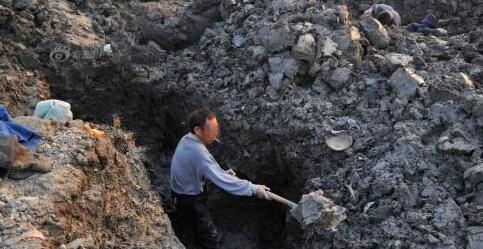Due to the extremely long history of China, it has experienced many dynastic changes, and many cultural relics recorded in history books are missing. As the saying goes, stepping on the iron shoes is nowhere to be found, it takes no effort to get it, and the discovery of some cultural relics is extremely accidental, and it seems that it is doomed in the dark, such as the next thing to say.

In the 1980s, in Mahu Village, Xuyi County, Jiangsu Province, a farmer named Wan Yiquan came to the farmland to dig a water canal. It was almost noon, he was tired and sweating, and just as he was about to dig a little longer to go home for dinner, he suddenly dug out a very hard thing. Because it was wrapped in dirt, wan yi thought it was a stone, so he picked it up with a shovel and prepared to throw it aside.
However, when he got the "stone" up, because a part of the dirt on it fell, he found that it was not a stone, but probably a piece of metal. So Wan Yiquan washed him with water, and happily almost closed his mouth, because you are an animal made of metal. In addition, according to his experience, although the metal is golden yellow, its material should not be brass, otherwise it would not be so heavy.
Underneath the metal, there were also some words that could not be understood, and he realized that it might be an ancient artifact. Wan Yiquan went home with a shovel in one hand and metal in the other, hummed a little song, and showed it to the neighbors to see if anyone knew what it was. Not long after, the news of Wan Yiquan's excavation of cultural relics spread, and after the Nanjing Museum heard about it, archaeologists quickly came to Wan Yiquan's home.
When seeing this piece of metal, experts were shocked, because not only the shape is peculiar, but also according to the above text, it can be inferred that it is a cultural relic of the Western Han Dynasty, which has a history of two thousand years, and its historical value is self-evident. Wan Yiquan heard that it was a cultural relic from two thousand years ago, and immediately expressed his willingness to hand it over to the museum, and the experts praised his approach and gave him a certain reward.
According to the careful study of experts, it was found that the material of the cultural relics was gold, with a gold content of up to 99% and a weight of more than 18 kilograms, which was the heaviest piece of gold found in mainland archaeology. However, there is a problem that confuses experts, because the shape of the artifact is so peculiar, no one can be sure which kind of animal it is. Some people say it is a tiger, some people say it is a leopard, and even some people say that it is a lion, and there is still no convincing answer, so they named it "Western Han Golden Beast".
On the inner wall of the base of the Western Han Dynasty Golden Beast, the words "Huang Liu" are engraved, and its font is Xiao Seal. In general, most of the ancient gold ware was made of pounding, but the Western Han Dynasty golden beast is an exception, it is the perfect combination of ancient metal casting technology and gold pounding technology. Nowadays, the Western Han Dynasty Golden Beast has been rated as a national treasure level cultural relics and is collected in the Nanjing Museum.